
The Low Moor and Clifton Colliery Tramways: Track & Inclines - 3
Low Moor Tramway Page 1 Low Moor Tramway Page 2 Low Moor Tramway Mapping
Track
Once Thomas W Ward acquired the Low Moor Ironworks and Tramways little time was lost in disposing of the assets deemed redundant. It follows that there is going to be very little left of a tramway which is being demolished which terminates in a blast furnace. However, a section of rail and its chair did survive at Ox Close until earlier this year, as the image taken in 2007 below shows.
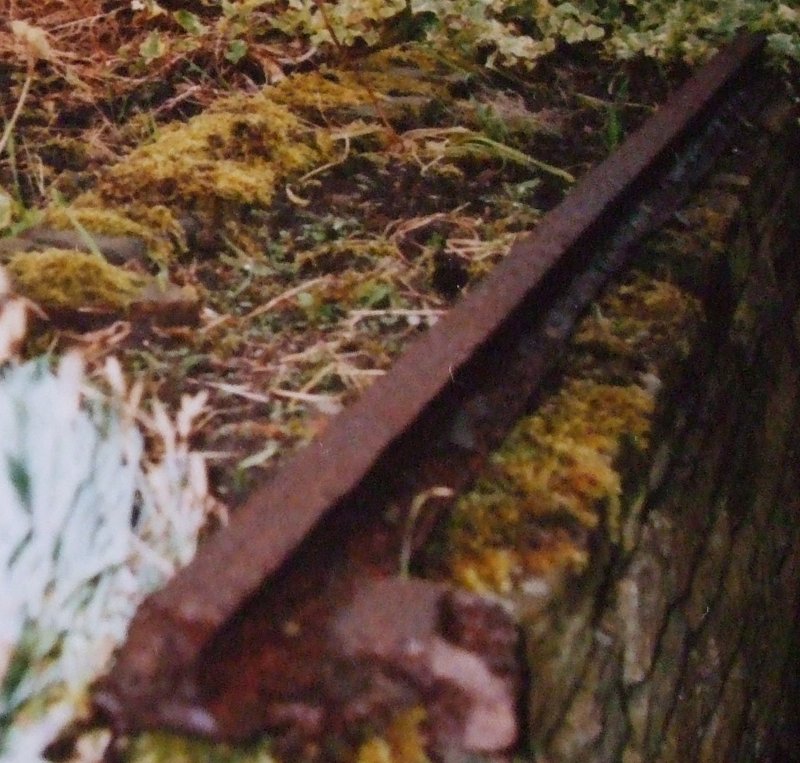
Photographer & copyright: Anne Hewland
This is presumed to be Low Moor rail, and would have replaced the earlier Clifton Colliery track. Photos of the Low Moor tramway within the works shows such rail in use. The chair would have been needed to fix the rail to the stone blocks. It is presumed that this aspect of the tramway was not updated south of Cow Lane, as this section remained rope worked to the end.
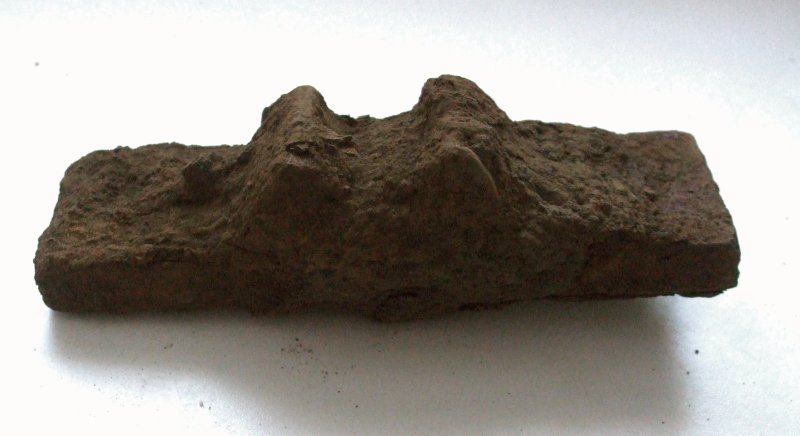
Photographer & copyright: Anne Hewland
Tramway chair as found at Ox Close, Clifton, in March 2017. This differs significantly from the chair recorded by B Thorp [19] further north. Given this was found at Ox Pit, where the Clifton and Low Moor tramways met, then this might be a Clifton chair, reflecting a different rail section, so possibly 'T' section rather than the later double- or bull-head type, or even a flat-bottom type, as found as a fence post near by (see below).
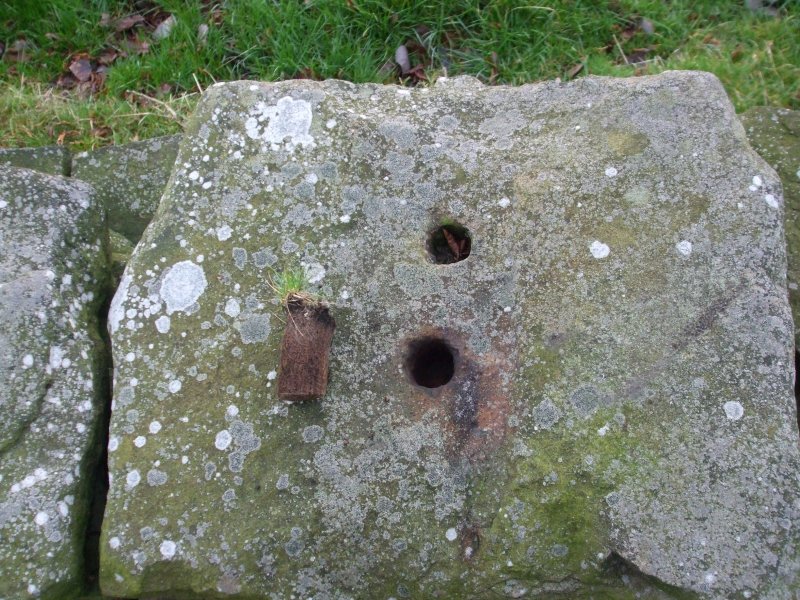
Photographer & copyright: Anne Hewland
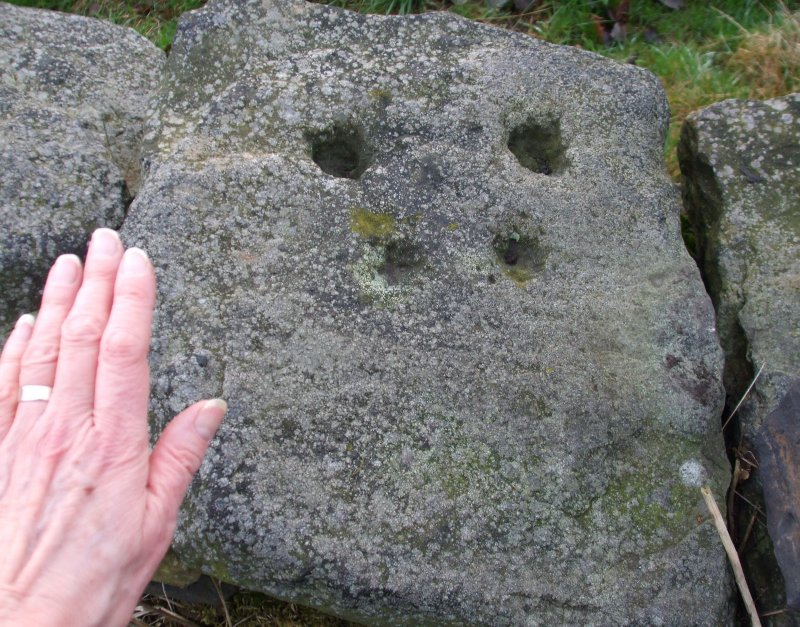
Photographer & copyright: Anne Hewland
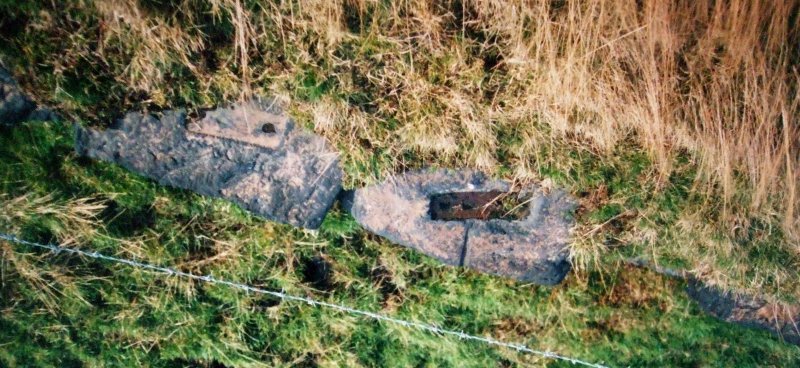
It us unclear whether this is a piece of Clifton Colliery rail or a piece of angle iron, but it forms a pence post on the site of Ox Pit.
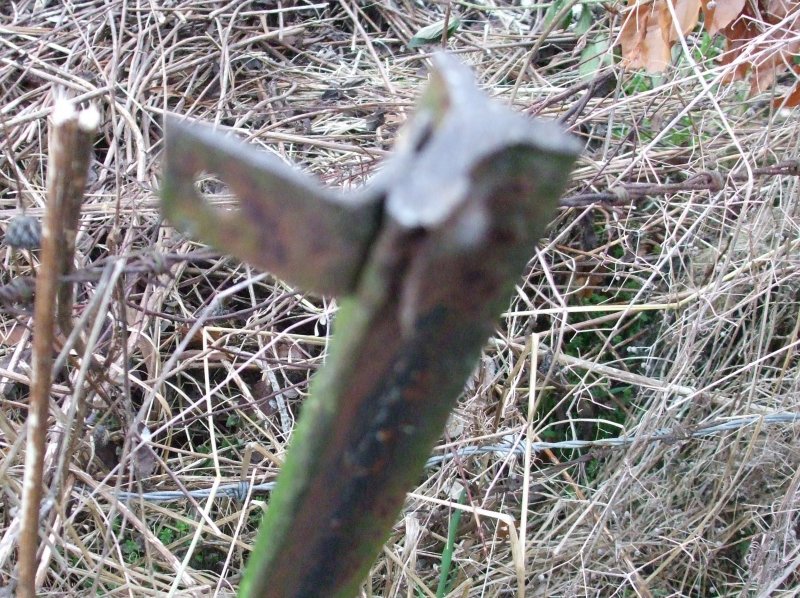
Photographer & copyright: Anne Hewland
Inclined Planes
Right from the very start, railways had to negotiate hills and valleys. Before 1804 the primary means of propulsion was the horse, and so the early engineers attempted to create a level track so that the horse could pull a reasonable maximum load. When there was no alternative, the engineer would create a long, steep incline with some form of mechanism at the top to either haul or regulate the passage of waggons up and down. This was the 'dry' equivalent of the then current 'wet' canal technology, with the level sections following the contour lines where possible, with any significant gradients tackled in one 'rise' or incline, in the fashion of a 'rise' of canal locks. Indeed, the early canal surveyors had become well-practiced at their art, and so the relative ease with which these early tramways were surveyed should come as no surprise.
In his study of the tramway, B Thorp [19] suggests that the Clifton Colliery incline was self-acting.
In November 1824 Josias Jessop was setting out the results of the Survey he had undertaken for the promoters of the Cromford and High Peak Railway, some 10 years before the Clifton Colliery line was being laid out.
In his document, Jessop makes the case for a railway with inclined planes and stationery engines. He wrote:
"The old system of forming railways , was to make them a with a regular inclination, adapted to the natural declivity of the country through which they passed; so that a horse had to perform the labour of ascending as well as overcome the friction of the carriages, (for beyond a very small rise, a locomotive Engine will no work to advantage,) the improvement has been to separate as far as possible, the Mechanical Power from the friction, concentrating the power at fixed points, where by means of stationery Steam Engines applied to Inclined Planes, the ascents are overcome at once, leaving only the friction and the distance to be done by the horse or the locomotive Engines. A Railway on this system is therefore equally suited to a mountainous or level country, and either Horses or Locomotive Engines may be used upon it (though not both with advantage at the same time from their difference in velocity,) the waggons been drawn along by the Locomotive Engine, which derives its motion from the contact and friction of the wheels against the rails, the wheels being attached directly to the Steam Engine." [15]
This sets out the case for a railway worked by stationery engines. The issue for Low Moor was that it had few, if any, obvious level sections for horse and/or steam engine working, and in the end, employed all three. Whilst Jessop is stressing the division of friction and velocity, it also clear that working a series of inclines is anything but quick, with loads limited to what the rope could reasonably cope with. But in the context of Low Moor, if one thinks of the tramway as a type of conveyor belt then so long as a steady flow of coal and limestone sufficient to maintain the work rates at the furnaces, the actual transit times of individual loads is therefore not so critical.
In 1800 work started on the first Penryn Quarry Railway. Two aspects of the this operation are worthy of note. Firstly, the loads were from the quarries high in the Welsh mountains down to the Port, so the gradient favoured the traffic flow. Secondly, the primary traffic was finished slate and related products, so any coal required to work steam engines or similar would have to be laboriously and expensively drawn up the hillside. The Welsh solution adopted in the Penryhn, Dinorwic, Festiniog and Nantlle quarries was a double track incline (so two separate tracks) laid side-by-side with a large drum at the top, with a brake fitted to it. Then a rope was fastened to the empty waggons at the bottom of the incline, and then fed up the track over a series of rollers laid in between the rails, and then was wrapped a few times round the drum at the top before being attached to the loaded waggons standing on the second track waiting to be let down.
Operation was now simple. The loaded waggons were pushed over the edge (the 'crimp') and then their downward speed checked by application of the drum brake. The attraction of this operation is that it did not require any external power to be applied, so once set-up, except for the manpower and maintenance involved, was cheap to run.
It will be apparent that if one set of waggons is passing down the incline at the same time another set is ascending, that give or take a few inches, they will pass at the mid-point of the incline. Engineers soon realised there was a more economical way of setting out the incline, with just three rails instead of four. But in this arrangement, the middle rail is shared between the two tracks, and only at the mid-point do they separate to allow the up-bound load to pass the downward load. This saves both on the quantity of rail needed and the land take for the incline. Again, this lends itself to the using gravity as the means of propulsion.
Finally, neither of these arrangement are possible, then a single line of rails can be used. The lowering down is simple enough, but the winding up needs a power source. With a colliery system - where loaded waggons of coal pass the incline head on a daily basis - it is possible to install a steam engine that provides the power for winding loads to the top of the incline. For completeness, water power could also be used, as happened on the early Ffestiniog at Moelwyn before the original tunnel was cut. In that particular example, loaded waggons were being hauled to a summit, before being let down the other side in a more conventional arrangement. Even in the Ffestiniog's horse-worked days this arrangement created a severe bottleneck, and a tunnel was driven to allow the passage of horse-drawn trains. When the railway was subsequently converted to steam locos, this tunnel then proved to be a new bottleneck, and consequently the Ffestiniog always had a reputation for having a very tight loading gauge in the tunnel. This was only finally resolved when the Ffestiniog was forced to build a new route and tunnel in the 1980s.
Various sources suggested the incline into Brighouse was co-acting (so loads passing each other). Other sources refer to the Brake Head engine, suggesting a powered incline. The available mapping (all OS map examined in the period 1848 - 1920) show a single line of rails and no intermediate pass-by or crossing loop.
However B Thorp [19] suggests that the Brighouse incline drew on the technology being developed in the North East around Newcastle. He suggests that the incline had two tracks in the upper section which used a common (middle) rail, and then opened out into two tracks to form a passing loop in the middle of the incline at Cock Walk Farm, before merging to form a single track down to Brighouse.
The incline and the Brighouse branch was formally abandoned on 29 February 1920, when the leases expired. The land in Brighouse was then offered for sale, so clearly as far as the Armytage estate was concerned, operations over the tramway had permanently ceased and there was no prospect of traffic resuming at some future time. Given the poor financial state of the Low Moor Company at this time, and the various surveys and reports that had highlighted the high cost of running the system, it is very probable that the incline winding gear - particularly if steam powered - now needed updating and replacing after 86 years of continuous operation. The early pits that had supplied Brighouse at Clifton and Ox Pit had been closed by 1907, and coal for Brighouse was now coming up from Three Nuns. But because of the loading gauge restriction in Clifton Common road tunnel, loads were having to be transhipped into the smaller capacity corves, so a further nail in this particular coffin.
The Low Moor system 'proper' was rope worked, with engine houses dotted along the route performing two operations: pulling loads towards the engine house, or lowering them down the other side. It follows that for more efficient operation, the engine house need to be located on a summit to perform these two types of operation. It also follows that level crossings on busy roads are going to be problematical, as from time-to-time there will be a rope - sometimes moving - crossing the highway. In this respect, it is a shame no one thought to photograph the bottom of the Clifton Common incline, which exited directly onto the Wakefield Road in Brighouse.
There are three clear problems with this arrangement:
1. in the event of a runaway, there is nothing to stop the waggons sweeping everything before them directly into the public highway at the bottom
2. the mechanics of attaching and unattaching the haulage rope would have seriously delayed traffic into and out of Brighouse
3. should the waggons have been run across the road still attached to the rope, the latter would have been a serious inconvenience to road users.
Also operational in this area were 'tubs' on a continuous rope. This arrangement was less severely graded but involved small tub waggons being tied to a rope roughly 10 foot apart, so that a waggon would pass the loading or unloading point once every 30 seconds. B Thorp [19] believes that the single track incline from Hartshead to Three Nunns operated on this principle. At the end of the section the rope would pass around a wheel allowing the tubs to return on the other track. The writer has seen a photograph of this arrangement in the Low Moor area but does not know where it was located.
Acknowledgements
I am very grateful to Mary Twentyman and Anne Hewland for the guidance, information and materials provided whilst compiling these notes.
Bibliography
1. The Narrow Gauge Number 205
Memories of the Narrow Gauge at Low Moor: Norman Boyes p. 3-5
Norman Boyes joined the Low Moor foundry in1930 and records the last years of the narrow gauge within the foundry. 3 half tones.
2. The Narrow Gauge Number 207
Low Moor Noel Donnelly 1 page. Noel provided five photographs, one of which shows the mixed gauge track crossing the road prior to entering the Old Works.
3. The Development of the Mineral Tramway System in Bradford
Reverend John Wilding. 20 pages
4. "Pennine Journey"
BEING THE HISTORY of the RAILWAYS, TRAMWAYS and CANALS in HUDDERSFIELD and DISTRICT.
by William B Stocks 1958. Printed and Published by THE ADVERTISER PRESS LTD., Huddersfield.
"The Low Moor Colliery Tramway" Pages 57 and 58.
5. A Study of the Railways built to Convey Coal and Iron Ore to Low Moor Iron Works
J. Dickinson 13 pages
6. Industrial Archaeology: The Journal of the History of Industry and Technology
Voume 8, Number 2, May 1971
The Low Moor Ironworks, Bradford. Charles Dodsworth Pages 122-164
7. The Low Moor Company: Report on Iron and Coal Mines, addressed to Lawrence Hardy, Manager by Sir M T Lewis, 1886
8. Down the Acres: The History of the Farms, Inns and Halls of Clifton, a West Yorkshire Village
Margaret Sharp. Bighouse and District Historical Society 2012
9."I Didn't Know That": Glimpses of the History of Clifton, a West Yorkshire Village
Margaret Sharp. Self-Published 2009
10. Brighouse Echo article Spring 1994 Chris Helme
11. Verbatim notes taken on a visit by Roy Black to Ox Close, 13 March 1994
12. A Record of the Origin & Progress of Lowmoor Iron Works from 1791 to 1906
A Google facsimile can be downloaded here.
13. The Locomotives built by Manning Wardle & Company - Volume 1 Narrow Gauge
Century Locoprints: Fred W Harman
14. Pennine Journey - Being the History of the Railways, Tramways and Canals in Huddersfield and District
by William B Stocks 1958, The Advertiser Press, Huddersfield p 57 - 58
15. The Cromford & High Peak Railway, published by Martin Bairstow
John Marshall, 1996
16. The Penrhyn Railway, published by the Welsh Highland Railway (1964) Ltd.
Charles E. Lee, 1972
17. A History of the Middleton Railway Leeds published by The Middleton Railway Trust Museum 2004
18. How Ffestiniog got its Railway published by The Railway & Canal Historical Society, Caterham
M.J.T. Lewis 1968
19. A Study of the Railway built to Convey Coal and Ironstone to Low Moor Ironworks, from notes by J Dickinson and edited and amplified by B Thorp
20. Little Giants: A History of the Ffestiniog Railway's Pre-Revival Locomotives; Their Mentors, Manufacture and Maintenance Chris Jones and Peter Dennis
Low Moor Tramway Page 1 Low Moor Tramway Page 2 Low Moor Tramway Mapping
